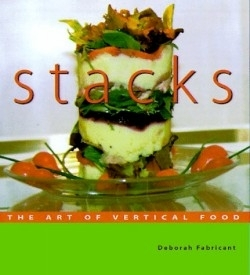Stacks
The Art of the Vertical Food
Will Stacks solve readers? dinner dilemmas and turn them into better cooks? Probably not. Will it banish boredom and bring fun and excitement into their kitchen? Almost certainly. Self-proclaimed non-professional cook Fabricant has put together a cookbook that highlights one method: stacking food. She presses foods into cylinders, into pie pans, and into pyramids. She free forms ingredients. The combinations are endless. Her results are exciting and eye-catching.
Riding on the coattails of restaurant chefs, Fabricant brings vertical food into the realm of the homecook. Now homecooks can impress their guests with food that looks as if it came from a professional kitchen. This book is less a cookbook and more a collection of appetizing combinations, eye-catching photos and instructions for the construction and presentation of food. Stacking is a technique that might just tempt a wanna-be-architect-cook or kids off the couch and into the kitchen.
Fabricant’s book is divided into six categories: Starter Stacks, Salad Stacks, Seafood Stacks, Savory Stacks, Sweet Stacks and Basic Stacks. Her stacking combinations are profuse and mouth-watering, sometimes overwhelming: Roasted Vine Tomatoes, Pesto, Mozzarella, and Pinenuts with Sundried Tomato Vinaigrette Stacks; Fruited Saint Andre Stacks; Seafood Risotto Stacks; Grilled Prawns, Lemon Risotto, Asparagus, and Ginger, with Mango-Watermelon Salsa; Sesame Chicken Tenders with Tomato Chutney and Polenta; and Shortbread, Roasted Apricots, Tapioca and Almonds with a Caramel-Grand Marnier Sauce.
Good cooking and good cookbooks are in the details. Fabricant starts out describing her method and its creative potentials. She gives readers information on equipment, advance preparation, photos and a “stacks matrix” of suggested foods. It is when she enters the arena of cooking technique that she becomes less effective.
There are, for example, different directions for risotto (a favorite stacking item of Fabricant’s). Each one gives different information. The directions for caramelized onions assumes that the reader knows what caramelization looks like.
Fabricant also could have made this first book more available to less experienced cooks. She could have been more consistent and effective if she?d employed “master” recipes with lots of detail. To get a full picture readers will have to do some sleuthing on their own.
Though this book has flaws, it still has the capacity to get readers excited and thinking creatively. Experienced homecooks who can fill in the blanks of technique will find it a treat for creating festive party food. Although an entire diet of this book could overtax the reader, it’s a great book to dip into for inspiration. If readers are adventurous and flexible, they will be excited by the amazing results and tasty combinations that Fabricant has designed.
Reviewed by
Nancy K. Allen
Disclosure: This article is not an endorsement, but a review. The publisher of this book provided free copies of the book to have their book reviewed by a professional reviewer. No fee was paid by the publisher for this review. Foreword Reviews only recommends books that we love. Foreword Magazine, Inc. is disclosing this in accordance with the Federal Trade Commission’s 16 CFR, Part 255.

